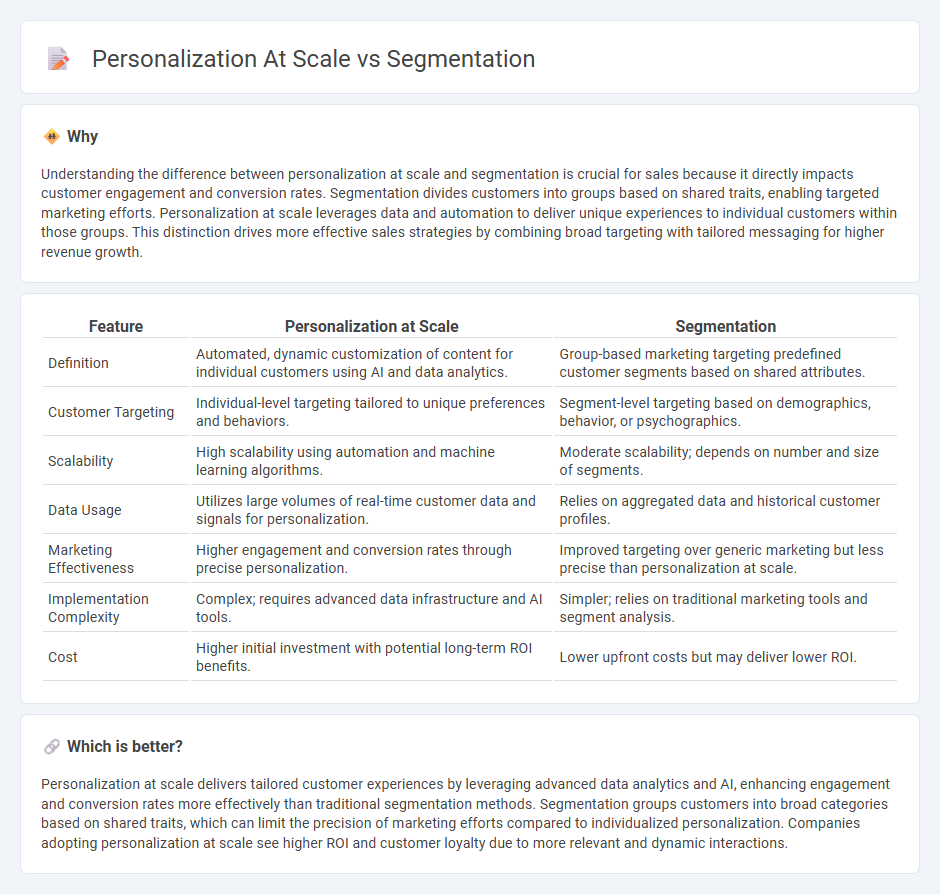
Personalization at scale leverages advanced data analytics and AI technologies to deliver tailored customer experiences across diverse channels, surpassing traditional segmentation methods that categorize audiences into broad groups. This approach enables businesses to predict individual preferences and behaviors, increasing engagement and conversion rates effectively. Discover how scalable personalization revolutionizes sales strategies and drives growth.
Why it is important
Understanding the difference between personalization at scale and segmentation is crucial for sales because it directly impacts customer engagement and conversion rates. Segmentation divides customers into groups based on shared traits, enabling targeted marketing efforts. Personalization at scale leverages data and automation to deliver unique experiences to individual customers within those groups. This distinction drives more effective sales strategies by combining broad targeting with tailored messaging for higher revenue growth.
Comparison Table
| Feature | Personalization at Scale | Segmentation |
|---|---|---|
| Definition | Automated, dynamic customization of content for individual customers using AI and data analytics. | Group-based marketing targeting predefined customer segments based on shared attributes. |
| Customer Targeting | Individual-level targeting tailored to unique preferences and behaviors. | Segment-level targeting based on demographics, behavior, or psychographics. |
| Scalability | High scalability using automation and machine learning algorithms. | Moderate scalability; depends on number and size of segments. |
| Data Usage | Utilizes large volumes of real-time customer data and signals for personalization. | Relies on aggregated data and historical customer profiles. |
| Marketing Effectiveness | Higher engagement and conversion rates through precise personalization. | Improved targeting over generic marketing but less precise than personalization at scale. |
| Implementation Complexity | Complex; requires advanced data infrastructure and AI tools. | Simpler; relies on traditional marketing tools and segment analysis. |
| Cost | Higher initial investment with potential long-term ROI benefits. | Lower upfront costs but may deliver lower ROI. |
Which is better?
Personalization at scale delivers tailored customer experiences by leveraging advanced data analytics and AI, enhancing engagement and conversion rates more effectively than traditional segmentation methods. Segmentation groups customers into broad categories based on shared traits, which can limit the precision of marketing efforts compared to individualized personalization. Companies adopting personalization at scale see higher ROI and customer loyalty due to more relevant and dynamic interactions.
Connection
Personalization at scale relies heavily on effective segmentation to target distinct customer groups with tailored marketing strategies. By organizing data into meaningful segments based on behavior, demographics, and purchasing patterns, sales teams can deliver customized experiences that increase engagement and conversion rates. This connection enhances customer satisfaction and drives revenue growth by aligning product offerings with individual needs at a large scale.
Key Terms
Customer Profiles
Segmentation categorizes customers into distinct groups based on shared attributes, enabling targeted marketing campaigns with broad relevance. Personalization at scale leverages detailed customer profiles and real-time data to deliver individualized experiences across multiple channels, driving deeper engagement and loyalty. Discover how integrating advanced customer profiling techniques can elevate your marketing strategies and boost conversion rates.
Targeted Messaging
Segmentation divides audiences into distinct groups based on shared characteristics, enabling targeted messaging that addresses specific needs and preferences. Personalization at scale leverages data and automation to create individualized experiences, delivering relevant content to each user in real-time. Explore how integrating both strategies can enhance campaign effectiveness and customer engagement.
Automation
Segmentation divides audiences into defined groups based on shared characteristics, enabling targeted marketing campaigns, while personalization at scale uses automation and AI to deliver highly individualized content to each customer in real-time. Marketing automation platforms integrate data from multiple touchpoints to dynamically tailor messages, improving engagement and conversion rates across large customer bases. Explore how automation transforms segmentation into scalable personalization for maximum business impact.
Source and External Links
Market segmentation - The process of dividing a consumer or business market into meaningful sub-groups called segments to identify profitable targets and tailor marketing strategies accordingly.
What is Segmentation? Definition & Examples - Segmentation is a marketing strategy that divides a large target audience into smaller, more specific groups based on shared characteristics to create more targeted campaigns.
Segmentation in Operating System - In computing, segmentation is the division of a program into variable-sized chunks called segments, which represent distinct parts of the process.
 dowidth.com
dowidth.com